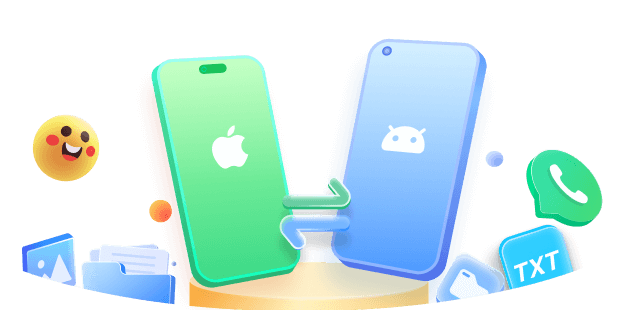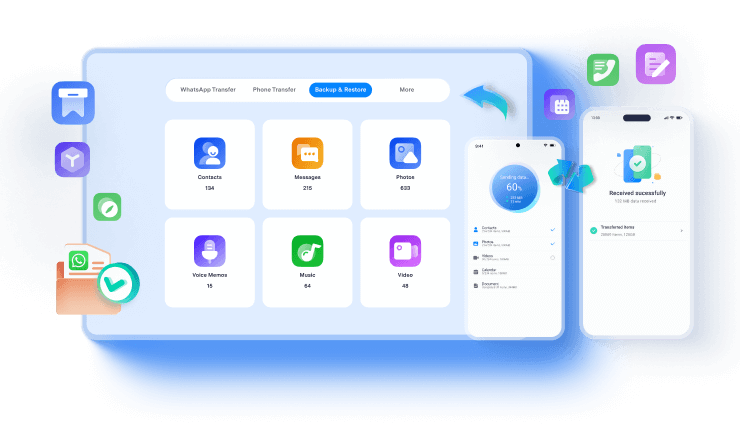Have you ever felt like your iPhone or iPad's music app is acting up? Wondering how do i turn off iCloud music library? Well, maybe your songs aren't syncing right across devices, or your iCloud storage is running low. If that's the case, turning off the iCloud Music Library might be the solution you need. This handy feature from Apple keeps all your tunes in sync, but sometimes, it can cause more problems than it solves.
Don't worry, though! This guide will show you exactly how to turn off iCloud Music Library on your iPhone, iPad, Mac, or even a Windows PC.
We'll cover everything step-by-step, from finding the right settings to what happens after you disable the feature. Plus, we'll share a neat tool to backup all your music files to your computer, just in case.
So, let's get started and take control of your music library once again!
In this article
Part 1: Why Turn Off iCloud Music Library?
Before diving into the steps to turn off the iCloud Music Library, let's explore some common reasons why you might want to do so:
- Manage iCloud Storage: The iCloud Music Library can quickly consume a significant portion of your iCloud storage space, especially if you have a large music collection. By turning it off, you can free up space for other important data like photos, documents, and backups.
- Avoid Sync Issues: While the iCloud Music Library is designed to sync your music seamlessly across devices, it's not uncommon to encounter sync issues or conflicts. Turning off the feature can help you avoid these problems and ensure your music library remains consistent.
- Prefer Local Management: Some users prefer to manage their music locally, either for privacy reasons or to maintain complete control over their library. Turning off the iCloud Music Library allows you to keep your music files on your devices without syncing them to the cloud.
- Compatibility Concerns: In some cases, the iCloud Music Library might not work well with certain music players or third-party apps. Disabling the feature can resolve compatibility issues and ensure smooth playback with your preferred music app.
Part 2: How to Turn Off iCloud Music Library
The steps for how to disable iCloud music library are different on each platform. Let’s walk you through how to turn off iCloud music library on iOS, Windows and Mac.
#1 Turn Off iCloud Music Library on iPhone and iPad
If you want to disable the iCloud Music Library on your iPhone or iPad, follow these simple steps:
Step 1: To get started, on your iOS device launch the “Settings” app. Now tap on "Music".

Step 2: Under the "Music" section, toggle off the switch next to "Sync Library."

Step 3: Confirm your decision by tapping "Turn Off Sync Library Music Library" when prompted.
#2 How to Turn Off iCloud Music Library on Mac
If you're using a Mac and want to turn off the iCloud Music Library, here's how to turn off iCloud music library on Mac:
Step 1: On your Mac, launch the default Music app. From the menu bar, click on "Music" and then select "Preferences."

Step 2: In the Preferences window, click on the "General" tab.
Step 3: Uncheck the box next to "Sync Library". And yes, don’t forget to hit the OK button to save changes.
#3 Disable iCloud Music Library on Windows
While the iCloud Music Library is primarily an Apple service, it can also be accessed on Windows PCs through the iTunes app or the Apple Music web player. To turn it off on a Windows machine, follow these steps:
Step 1: Open the iTunes app on your Windows PC. Click on the "Edit" menu and select "Preferences."
Step 2: In the Preferences window, click on the "General" tab. Now, uncheck the "Sync Library" option to turn off iCloud music library on Windows.

Step 3: Click "OK" to save your changes and exit the Preferences window.
Part 3: What Happens When You Turn Off iCloud Music Library?
When you turn off the iCloud Music Library, here's what you can expect:
- Local Music Library: Your music files will remain on your devices, but they won't sync with the cloud or other devices. Any changes you make to your music library, such as adding or deleting songs, will only affect the device you're using.
- Offline Access: You'll still have access to your music offline, but you won't be able to stream or download songs from the Apple Music catalog unless you have them locally stored on your device.
- Metadata Changes: Any metadata (artist, album, genre, etc.) changes you make to your songs will only apply to the device you're using and won't sync across other devices.
- Playlist Syncing: Your playlists won't sync across devices anymore. Any changes you make to a playlist will only affect the device you're using.
- Apple Music Subscription: If you have an Apple Music subscription, you'll still be able to stream and download songs from the Apple Music catalog, but they won't be added to your iCloud Music Library or sync across devices.
Part 4: Sync Your iPhone Music Files to PC via MobileTrans
Before turning off the iCloud Music Library, it's crucial to have a backup of your entire music collection on your computer. This way, you can safeguard your precious tunes and ensure you never lose them, even if something goes wrong with your devices or cloud storage. Plus, having a local backup makes it easy to transfer your music to a new device or restore it if needed.
While you can manually copy music files from your iPhone or iPad to your computer, the process can be tedious and time-consuming, especially if you have a large library. That's where MobileTrans comes in – a powerful and user-friendly tool designed to streamline the backup and transfer process for all your device data, including music.
Wondershare MobileTrans supports backing up and transferring not just music but also photos, videos, contacts, messages, and more between your iOS devices (iPhone, iPad, iPod) and computers (both Windows and Mac).
Wondershare MobileTrans
Back Up Your Data to Computer Easily
- • No data loss. No data leaks.
- • Support various data, including files, photos, videos, apps, contacts, etc.
- • Compatible with thousands of device types acorss Android and iOS.

 4.5/5 Excellent
4.5/5 ExcellentHere's how you can use MobileTrans to effortlessly backup your entire music library from your iOS device to your PC or Mac:
Step 1: Download and install the MobileTrans software on your device. Connect your iPhone, iPad, or iPod to your computer using a USB cable. Launch MobileTrans and select the "Backup and Restore" option from the main interface.
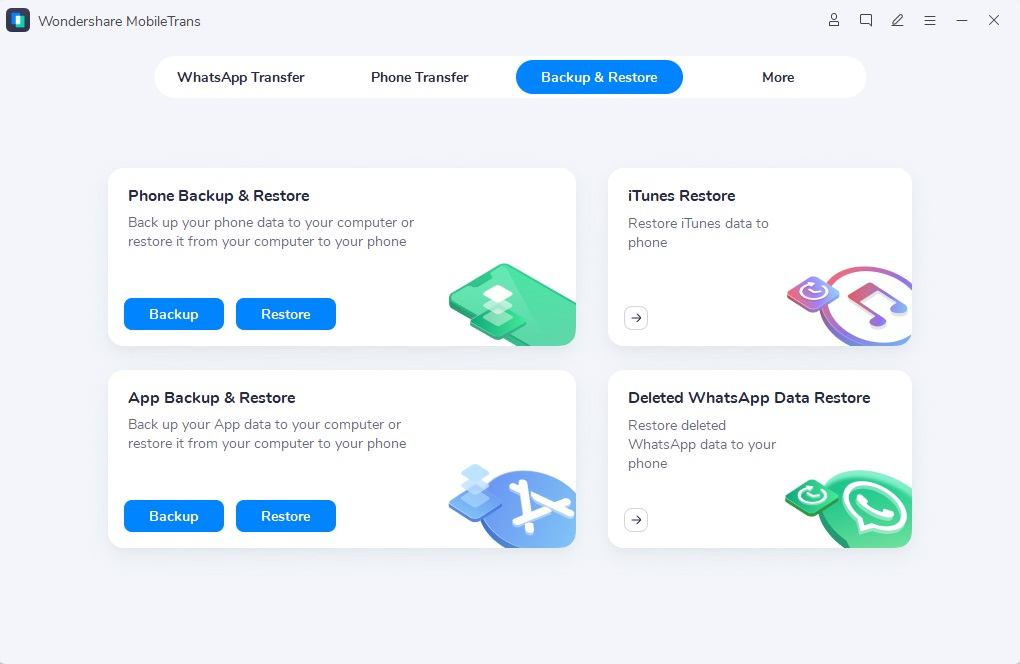
Step 2: Now click the “Backup” button placed in the “Phone Backup and Restore” section.
Step 3: Select the specific music files or playlists you want to backup. You can choose to back up your entire music library or only selected items. Hit the “Start” button.
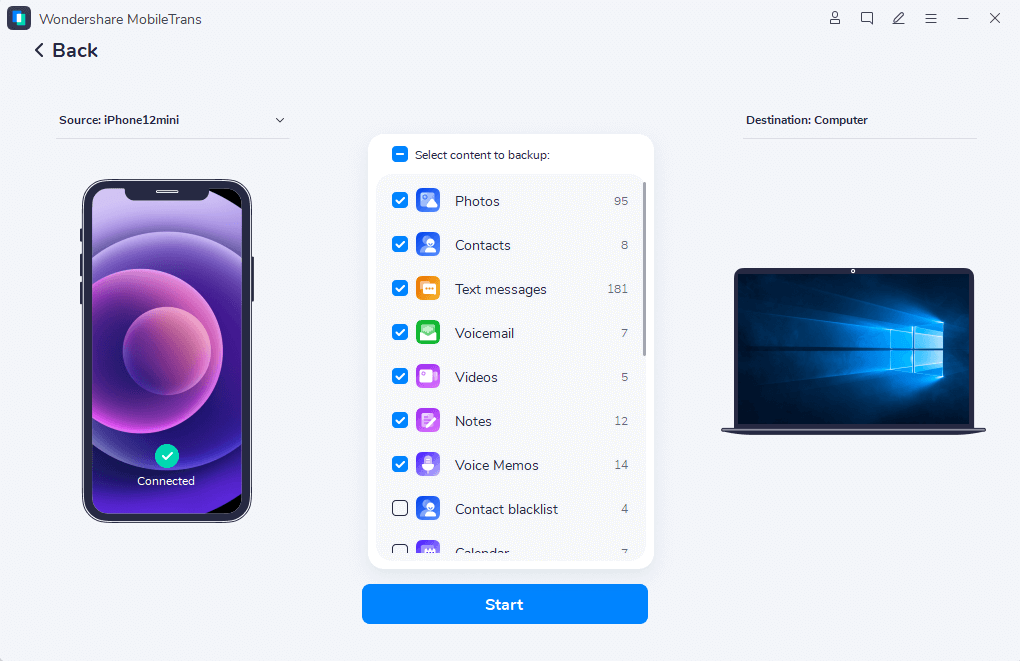
Step 4: MobileTrans will start transferring your selected music files from your device to your computer. Depending on the size of your library, this process may take some time.
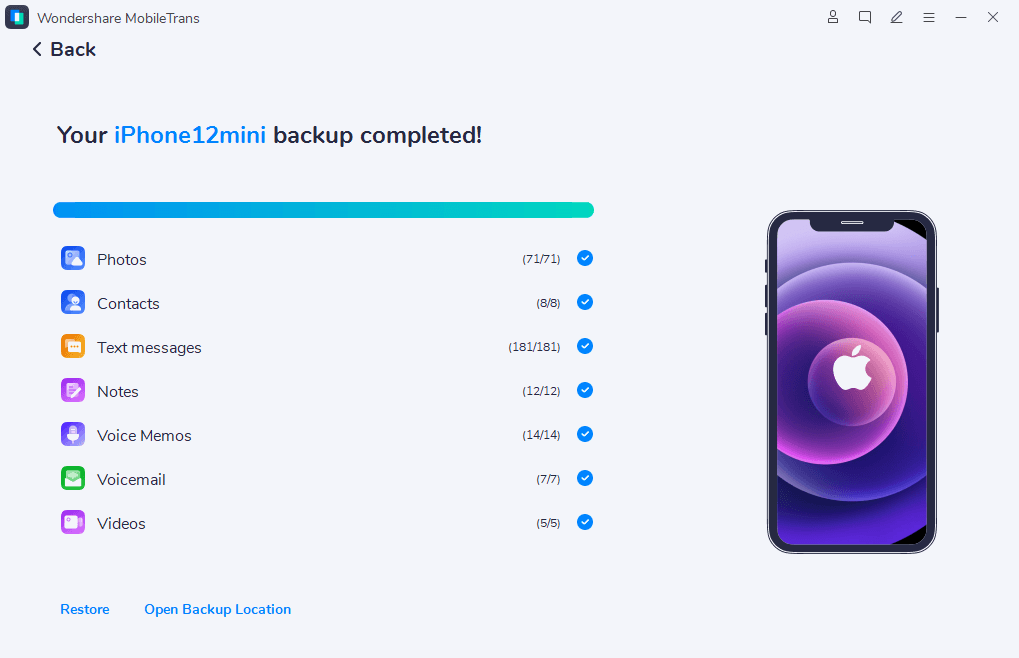
One of the best things about MobileTrans is its user-friendly interface, which makes the backup process straightforward and easy to navigate, even for those who aren't tech-savvy. The software also supports transferring data both ways, so you can use it to restore your music library from your computer to a new device whenever needed.
MobileTrans isn't just for music; it can also backup and transfer lots of other stuff like photos, videos, contacts, messages, notes, and calendars. It's super useful for keeping your important data safe and moving it between your devices.
So, before you turn off the iCloud Music Library, take a few minutes to back up your music files using MobileTrans. It's a simple step that can save you a lot of hassle and potential data loss in the long run.
Conclusion
Turning off the iCloud Music Library can be a simple yet effective solution for managing your music library locally, freeing up iCloud storage space, or resolving sync issues. By following the steps outlined in this guide, you can easily disable the iCloud Music Library on your iPhone, iPad, Mac, or Windows PC.
Remember, turning off the iCloud Music Library means your music won't sync across devices anymore, and any changes you make will only apply to the device you're using. If you have an Apple Music subscription, you'll still be able to stream and download songs, but they won't be added to your iCloud Music Library.
Before making any changes, it's always a good idea to back up your music files to your computer using a tool like MobileTrans. This will ensure you have a local copy of your music collection, which you can restore or transfer to a new device if needed.

 4.5/5 Excellent
4.5/5 ExcellentFAQ
-
Q: Will turning off the iCloud Music Library delete my music from my devices?
No, turning off the iCloud Music Library won't delete your music files from your devices. Your locally stored music will remain intact, but it won't sync with other devices or the cloud. -
Q: Can I still use Apple Music after turning off the iCloud Music Library?
Yes, you can still use Apple Music and stream or download songs from the catalog. However, these songs won't be added to your iCloud Music Library or sync across devices. -
Q: What happens to my playlists when I turn off the iCloud Music Library?
Your playlists won't sync across devices anymore. Any changes you make to a playlist will only affect the device you're using.
